1. The Great White Shark
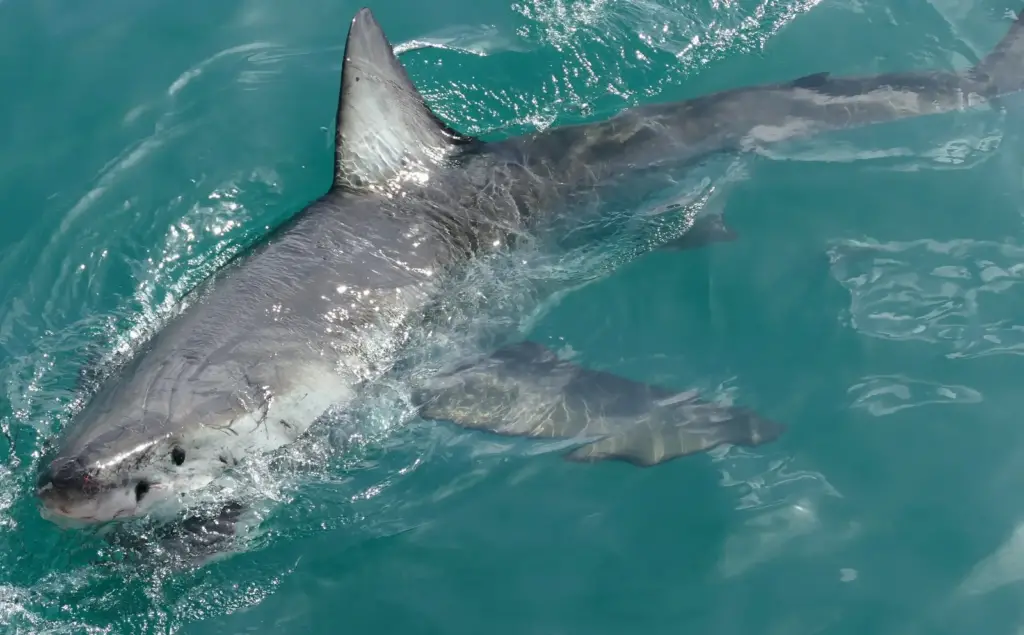
The Great White Shark is perhaps the most infamous shark species, known for its size, power, and dominance in the ocean. These apex predators can grow up to 20 feet in length and weigh over 5,000 pounds, making them one of the largest sharks in the world. Found primarily along the U.S. coastlines, Great Whites are commonly spotted in areas such as California, Florida, and the Northeastern U.S. Their distinctive, conical-shaped bodies and sharp, triangular teeth make them a fearsome presence in the water. While they are typically not aggressive towards humans, their size and strength often lead to dangerous encounters. Great Whites primarily feed on marine mammals, such as seals, sea lions, and even large fish.
According to Newsweek, one of the most famous Great White sharks is a female known as “Deep Blue,” which has been spotted off the coast of Mexico and is believed to be the largest Great White ever recorded. These sharks are also known for their ability to breach the water’s surface, launching themselves out in dramatic hunting displays. Though their population has been under threat due to overfishing and habitat loss, conservation efforts have been put in place to help protect them. The Great White’s ability to navigate long distances, migrate seasonally, and dive to depths of over 1,000 feet adds to the mystery and awe surrounding this species. Their intelligence and hunting strategy make them one of the most fascinating predators in the ocean. As with all shark species, maintaining a healthy respect for their presence is crucial for both conservation and safety.
2. The Whale Shark
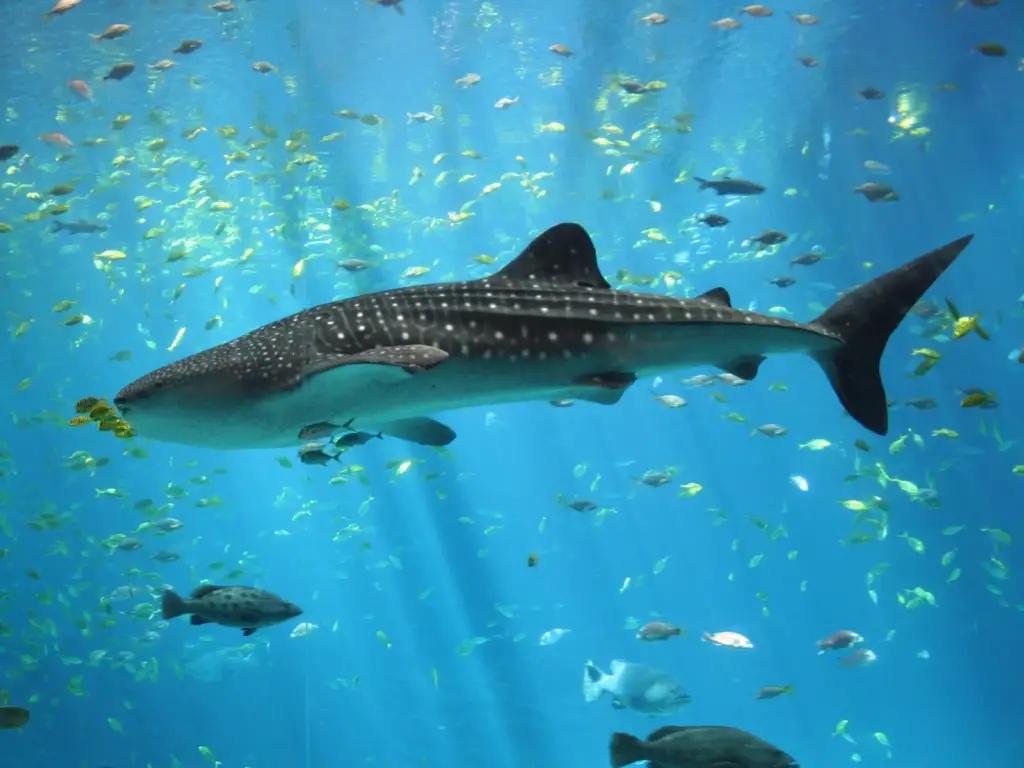
The Whale Shark is the largest fish in the world, growing up to an astonishing 40 feet in length and weighing more than 20,000 pounds. Despite their immense size, Whale Sharks are gentle giants, feeding primarily on plankton, small fish, and other microscopic organisms. These filter feeders swim with their mouths wide open, allowing water to pass through their gills and trap food particles. According to NOAA Fisheries, while they are found in tropical and warm temperate oceans, the U.S. is home to many Whale Shark sightings, particularly in the Gulf of Mexico and around the coastlines of Florida. Their distinctively patterned bodies, with light spots and stripes, make them one of the most recognizable sharks in the world.
While Whale Sharks have been spotted off U.S. shores for decades, sightings have become more frequent during the warmer months, when they migrate to areas rich in plankton. Despite their size, Whale Sharks are not dangerous to humans and are often a favorite for divers who seek to swim alongside them. These sharks can live for over 100 years, making them one of the longest-lived marine species. Whale Sharks are slow swimmers, but their size allows them to travel long distances in search of food. They play a crucial role in maintaining the balance of marine ecosystems by helping to control the population of plankton. Unfortunately, Whale Sharks are considered vulnerable due to fishing, ship strikes, and habitat destruction. Conservation groups are actively working to protect these majestic creatures and ensure their survival for future generations.
3. The Basking Shark
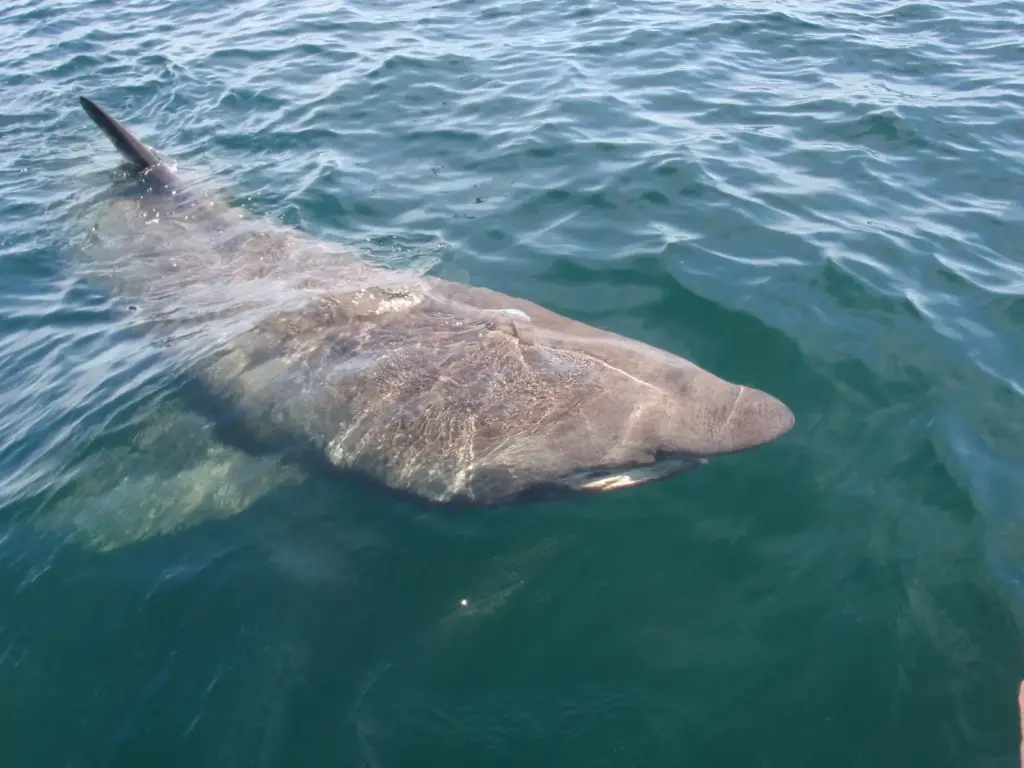
The Basking Shark is the second-largest species of shark in the world, growing to an impressive length of up to 26 feet and weighing nearly 10,000 pounds. Like the Whale Shark, Basking Sharks are filter feeders, swimming slowly through the water with their massive mouths wide open to capture plankton. These sharks can be found in the cooler waters of the Pacific Northwest and the Northeastern U.S., including areas like Massachusetts and Maine. According to the Florida Museum of Natural History, though they are often found near the surface, Basking Sharks are not a threat to humans due to their diet of plankton and small marine creatures. Basking Sharks are easily identifiable by their large, wide mouths and their pale gray to brownish bodies. They are often spotted swimming alone or in small groups, and their slow, gliding movements make them a serene sight in the water.
These sharks are migratory, moving in and out of coastal regions depending on water temperatures and food availability. Their slow swimming speed, reaching only around 3 miles per hour, makes them easy to track for researchers and wildlife enthusiasts. Despite their large size, Basking Sharks are not as well-known as some of their more predatory cousins, but they are an important part of the ocean’s ecosystem. Sadly, their population has been in decline due to overfishing and entanglement in fishing nets, leading to their classification as vulnerable on the IUCN Red List. Conservation efforts are critical for ensuring that this gentle giant continues to roam the oceans for years to come.
4. The Tiger Shark
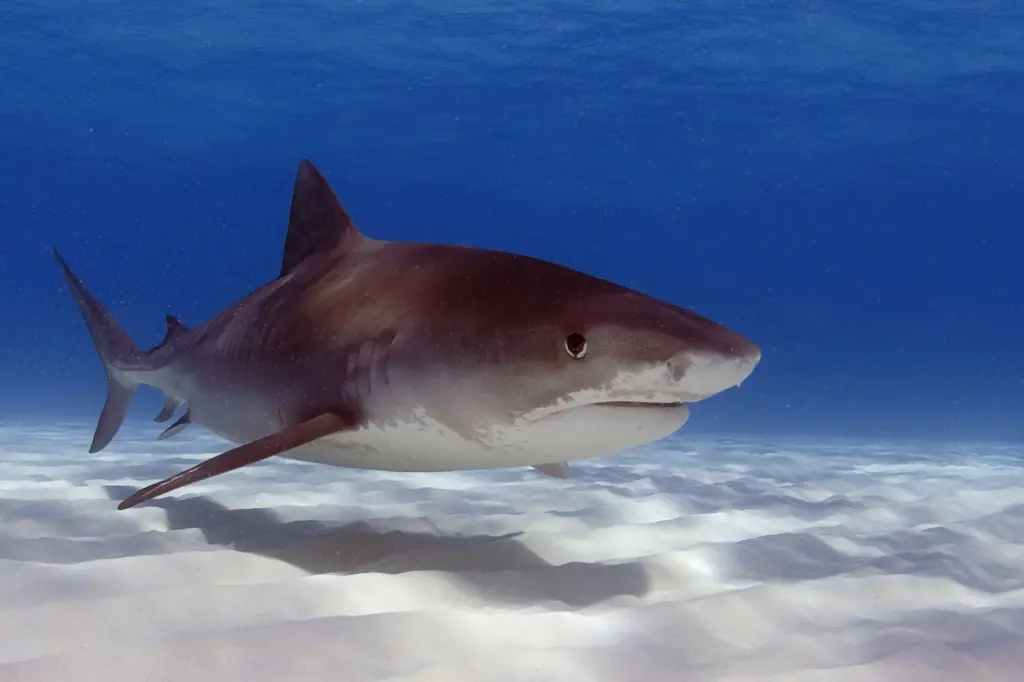
The Tiger Shark is one of the most formidable and dangerous shark species found near U.S. shores. Growing up to 18 feet long and weighing over 1,400 pounds, these sharks are known for their wide, flat heads and distinctive tiger-like stripes, which fade as they age. Found primarily in warmer waters along the coasts of Florida, Hawaii, and the Gulf of Mexico, Tiger Sharks are opportunistic feeders, consuming a wide range of prey, from fish and seals to birds, turtles, and even garbage. Their aggressive feeding habits and willingness to eat almost anything make them one of the most feared sharks in the world. Despite their fearsome reputation, Tiger Sharks play an essential role in maintaining the health of marine ecosystems by keeping populations of prey species in check. These sharks are solitary hunters, typically swimming alone or in small groups.
Known for their intelligence and ability to adapt to different environments, Tiger Sharks can be found in both shallow coastal areas and deep offshore waters. They are capable of traveling long distances in search of food, and their migratory behavior is still being studied by marine biologists. According to the Hawai’i Institute of Marine Biology, Tiger Sharks are often involved in attacks on humans, though these incidents are relatively rare, and most occur due to the shark mistaking a person for prey. While they are not actively hunted as much as other shark species, their population is threatened by habitat loss, overfishing, and hunting for their fins. Their unique coloration and hunting strategies make them a fascinating subject of study and an iconic species in the world of sharks.
5. The Mako Shark
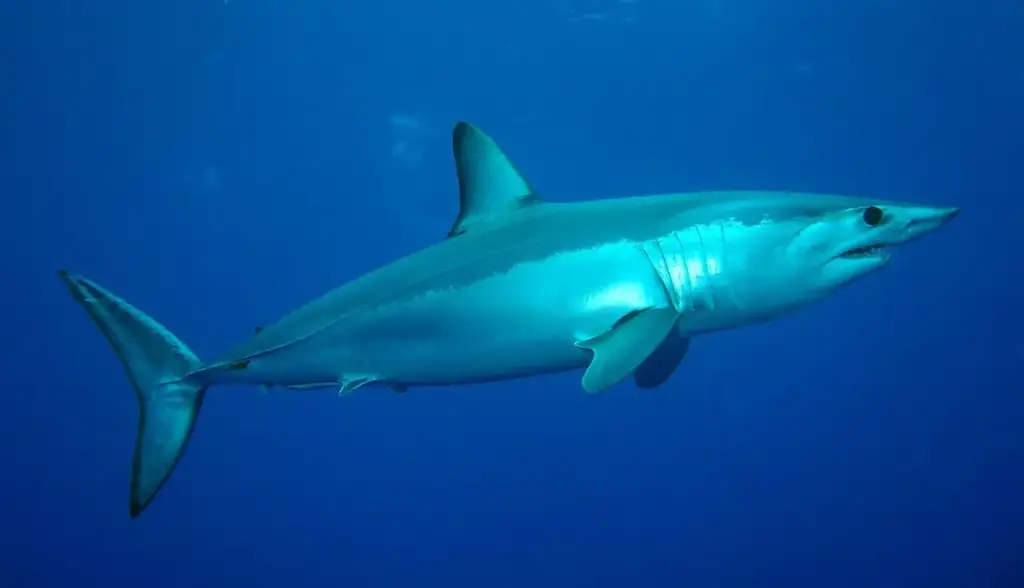
The Mako Shark is renowned for its speed and agility, earning it the title of the fastest shark in the world. While it may not reach the enormous sizes of the Whale or Great White Sharks, the Shortfin Mako can grow up to 12 feet in length and weigh around 1,200 pounds. These sharks are found in temperate and tropical waters, including the coasts of California, the Carolinas, and along the East Coast of the U.S. Mako Sharks are known for their sleek, torpedo-shaped bodies, which enable them to swim at speeds of up to 60 miles per hour, making them an apex predator in the open ocean. They are highly active hunters, preying on fish such as tuna, as well as marine mammals and even smaller sharks. Despite their size and hunting prowess, Mako Sharks tend to avoid coastal areas with heavy human traffic, preferring the open sea. Their sharp, pointed teeth and powerful jaws allow them to capture fast-moving prey with ease.
According to the Florida Fish and Wildlife Conservation Commission, Mako Sharks are also known for their incredible leaping ability, often breaching the water’s surface during hunting or in response to bait. This behavior, along with their speed, makes them a thrilling species to encounter for shark enthusiasts. While they are not considered as dangerous to humans as some other sharks, Mako Sharks have been involved in occasional attacks, often during fishing encounters. Due to their popularity in sport fishing and the demand for their meat and fins, Mako Sharks face threats from overfishing. Conservation efforts are underway to protect this magnificent species and preserve its role in the marine food chain.
6. The Goblin Shark

The Goblin Shark is one of the most unusual and eerie-looking species of shark in the world. With a long, flattened snout, protruding jaws, and pale, almost translucent skin, the Goblin Shark is often described as a “living fossil” due to its primitive features. These sharks can grow up to 12 feet in length and weigh around 500 pounds, though they are rarely seen in the wild due to their deep-sea habitat. Goblin Sharks are typically found off the coast of Florida and the Gulf of Mexico, although sightings are extremely rare, as they tend to inhabit depths of around 300 to 1,200 feet. Their long, needle-like teeth are adapted for capturing small fish, squid, and crustaceans, which they hunt by extending their jaws to snatch prey. This unique hunting strategy makes the Goblin Shark one of the most fascinating and mysterious species in the ocean. Despite their somewhat intimidating appearance, Goblin Sharks are not considered a threat to humans, as they are deep-sea dwellers and rarely come into contact with people.
The rarity of sightings has made the Goblin Shark a subject of intrigue for marine biologists and shark enthusiasts alike. They are often considered a “living fossil” because their evolutionary lineage can be traced back millions of years. Because of their deep habitat, studying Goblin Sharks is challenging, and much about their behavior remains a mystery. The conservation status of Goblin Sharks is not well-known due to their elusive nature, but like many deep-sea species, they may be at risk from deep-sea fishing and habitat disturbance.
7. The Hammerhead Shark
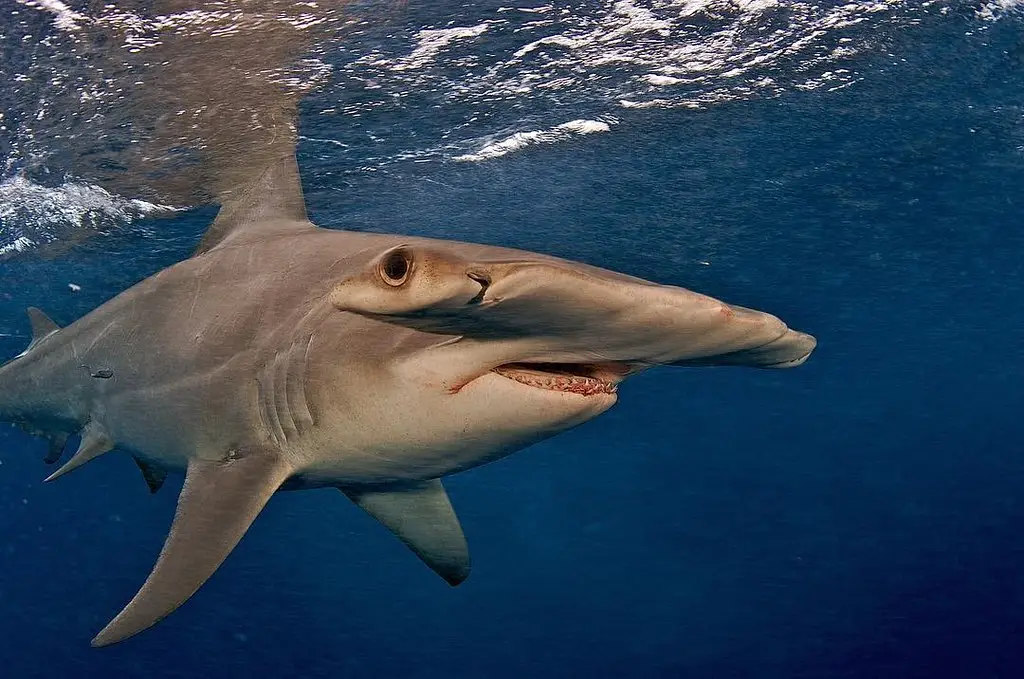
Hammerhead Sharks are among the most easily recognizable shark species due to their distinct, hammer-shaped heads, which give them a unique advantage when hunting. These sharks can grow up to 20 feet in length and weigh around 1,000 pounds. Found in warm waters off the U.S. East Coast, in the Gulf of Mexico, and around Hawaii, Hammerheads are often seen in schools near the shore, particularly during the warmer months. Their wide heads provide them with enhanced sensory capabilities, allowing them to detect the electrical fields produced by their prey in the sand. This adaptation makes them efficient hunters of rays, small fish, and crustaceans. Despite their intimidating appearance, Hammerhead Sharks are generally not a threat to humans, although they are capable of attacking if provoked.
There are several species of Hammerhead Sharks, including the Great Hammerhead, which is the largest and most aggressive, and the smaller Scalloped Hammerhead. These sharks are highly social and are often seen swimming together in large groups, particularly during mating season. Hammerheads are also known for their migratory patterns, moving to different areas in search of food and optimal breeding grounds. While their populations are relatively stable, Hammerhead Sharks face threats from overfishing, habitat destruction, and the shark fin trade. Their distinctive appearance and unique hunting methods make them an iconic species in the world of sharks, and they continue to intrigue researchers and marine enthusiasts alike.


